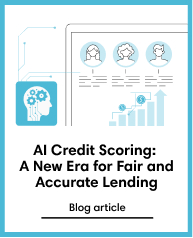Credit Scoring
Sep 10, 2021
How Technology Is Transforming the Financial Industry: Benefits, Trends & Impact
Subscribe to our newsletter
Introduction
Financial technology, or fintech, has transformed global banking. Once seen as a threat, it is now a collaborative force, with banks and fintechs working together.
Today, institutions use machine learning (ML), embedded systems, and digital platforms to boost performance, improve engagement, and prevent fraud.
Questions like how did stores begin to change as technology advanced reflect a broader shift across industries, including finance, where digital tools have reshaped operations, service, and decision-making.
This underscores how significant the role of technology is in transforming business models across sectors.
At first, banks saw the rise of fintech as a direct threat to their long-standing dominance in financial services.
However, nowadays they have progressed from a competitive relationship to a collaborative one , where both banks and fintech complement each other and provide the skills that the counterpart needs.
This article explores the top benefits of technology in finance for banks, with a focus on how innovation is driving increased efficiency, security, and customer-centric services across the industry.
What Is Financial Technology and Why It Matters Today
Fintech represents the fusion of finance and technology, introducing smarter, faster, and more accessible ways for people and businesses to manage money.
From online banking to mobile wallets, this blend has changed how we manage our finances.
More recently, advances in artificial intelligence (AI) and ML have driven innovation in credit scoring, fraud detection, and real-time risk assessment.
So, what is financial technology today? It is more than just apps; it is the fusion of finance and technology to create faster, more accurate, and more inclusive systems.
While AI drives industry-wide change, ML plays a key role in enabling real-time behavioural scoring.
Companies like Credolab use ML to process metadata securely and generate predictive credit scores, helping lenders make smarter, faster decisions with minimal risk.
Key Benefits of Technology in the Financial Industry
Enhanced Operational Efficiency
One of the biggest advantages of IT in finance is its ability to streamline operations. Cloud computing and ML allow financial institutions to automate manual tasks, reduce human error, and expedite decision-making.
For example, banks can quickly test and deploy alternative credit scoring models without long approval cycles or infrastructure bottlenecks.
Credolab’s use of metadata-based ML scoring is a prime example of automation improving speed and reliability.
By eliminating manual processing, financial institutions reduce costs and boost performance.
This is how IT in financial services modernises outdated systems and enables real-time, data-driven operations across departments.
Improved Customer Experience and Personalisation
From mobile apps to chatbots and 24/7 banking, fintech has transformed how customers engage with financial services.
Personalisation is now expected, and real-time credit scoring makes it possible.
Credolab’s ML models analyse behavioural data, such as app usage and swipe patterns, to personalise credit offers even before an application is submitted, ensuring a smoother onboarding process.
This is the case with alternative credit scoring, which enables precise credit profiling and opens access to unexplored segments using technology based on metadata and artificial intelligence.
By moving beyond traditional credit history, lenders can serve more customers with greater accuracy and relevance.
Advanced Risk Management and Fraud Detection
How can financial institutions avoid fraud? Security is also a key result of fintech innovation.
The impact of technology on financial services is most visible in risk management.
With fraud tactics becoming more complex, traditional systems often fall short. This is where AI, big data, and ML step in.
Credolab’s fraud detection tools use consented, anonymised signals to detect risk without compromising privacy, helping institutions stay ahead of cybercriminals while protecting customer trust.
This approach is a practical example of AI in credit risk management.
Cost Reduction and Financial Transparency
Digital transformation in IT for financial services cuts costs by automating tasks, reducing errors, and streamlining workflows.
Cloud-based tools improve budgeting and forecasting, allowing finance teams to focus on strategy.
Financial transparency ensures spending visibility, accountability, and trust, enabling smarter decisions and making finance a key driver of operational control and business efficiency.
Regulatory Compliance and Real-Time Reporting
In 2025, staying compliant with global standards, like GDPR, CCPA, and ESG-related mandates, is more critical than ever.
Fintech enables automated compliance checks, real-time audits, and instant reporting dashboards.
By digitising records and applying rule-based monitoring, institutions reduce risk and maintain transparency with regulators.

Emerging Technologies Shaping the Finance Industry
The rise of emerging technologies in the financial services industry is redefining how institutions manage risk, serve customers, and scale securely.
Among the most influential are AI, ML, predictive analytics, and API-based banking.
While blockchain and RegTech attract attention, it is ML algorithms that have become the backbone of real-time credit scoring and fraud detection.
In how Credolab works, ML extracts behavioural signals from anonymised metadata to generate accurate, privacy-compliant scores.
These predictive insights are especially valuable in underserved markets where traditional credit data is limited or unavailable.
The Changing Role of Finance Functions in the Tech Era
As finance departments become more tech-savvy, their role is shifting from record-keeping to strategic advisory.
Chief Financial Officers (CFOs) now rely on real-time dashboards, data visualisation, and scenario modelling tools to make faster, more informed decisions.
How does the finance function relate to company spending? It serves as the analytical engine that connects expenditure with business performance, enabling tighter cost control and more precise forecasting.
With the UK government’s Treasury planning to deploy real-time monitoring for departmental spending, the finance function has evolved from a back-office guardian of compliance to a front-line driver of agility and strategic insight.
Real-World Examples of Technology in Finance
Financial innovation is no longer theoretical; it is already shaping everyday experiences. Major banks now offer full-service mobile banking apps with biometric logins and 24/7 access.
Cross-border payments are faster and more secure thanks to blockchain protocols.
In credit scoring, ML is revolutionising decision-making. Credolab’s embedded scoring SDK allows lenders to evaluate applicants in real time using smartphone metadata, eliminating the sole reliance on traditional credit history.
This opens financial access while reducing fraud and operational delays. These same tools also support marketing solutions using behavioural data, helping institutions personalise outreach and retention strategies.
Challenges and Risks of Adopting New Financial Technologies
Despite the advantages, adopting new technology in finance is not without risk.
Cybersecurity remains a major concern, as increased digitisation invites new vulnerabilities. Furthermore, High implementation costs and the shortage of skilled tech talent can also slow transformation.
However, institutions that take a balanced approach—investing in training, choosing proven vendors, and aligning innovation with compliance—are better positioned to succeed.
Acknowledging these challenges builds trust and reinforces your organisation’s authority in the evolving financial landscape.
Future Outlook: What’s Next for Finance and Technology?
Which of the following are new advancements and changes in finance? Think hyper-personalised banking, decentralised finance, and embedded lending experiences powered by predictive algorithms.
The future will be defined by seamless, secure, and AI-enhanced platforms that offer users exactly what they need, when they need it.
For companies like Credolab, continued innovation in ML will unlock even more granular insights, reduce risk, and help financial institutions adapt quickly to whatever comes next.
These developments further amplify the impact of technology on financial services worldwide.
Conclusion
As the banking sector continues to evolve, fintech remains a key driver of innovation and resilience.
From enhancing operational efficiency to improving fraud prevention and personalisation, the benefits of ML-powered solutions are clear and measurable.
Financial institutions that partner with fintech providers gain the agility to meet changing customer needs, maintain compliance, and stay competitive in a digital-first economy.
By adopting ethical, data-driven tools, banks can transform credit decisioning and unlock greater financial inclusion.
Discover how Credolab is empowering financial institutions with real-time alternative credit scoring to drive smarter, faster lending decisions.
FAQs
What is financial technology?
Financial technology, or fintech, refers to digital tools like artificial intelligence, machine learning, and mobile apps that improve financial services by making them faster, more efficient, and accessible.
How does the finance function relate to company spending?
The finance function tracks, analyses, and manages a company’s spending to ensure financial health, optimise budgets, and support strategic decisions.
Which of the following are new advancements and changes in finance?
Key changes include decentralised finance, real-time credit scoring, and hyper-personalised banking experiences.
Which emerging technologies are used in the financial services industry?
Machine learning, API banking, predictive analytics, blockchain, and RegTech are leading innovations.





